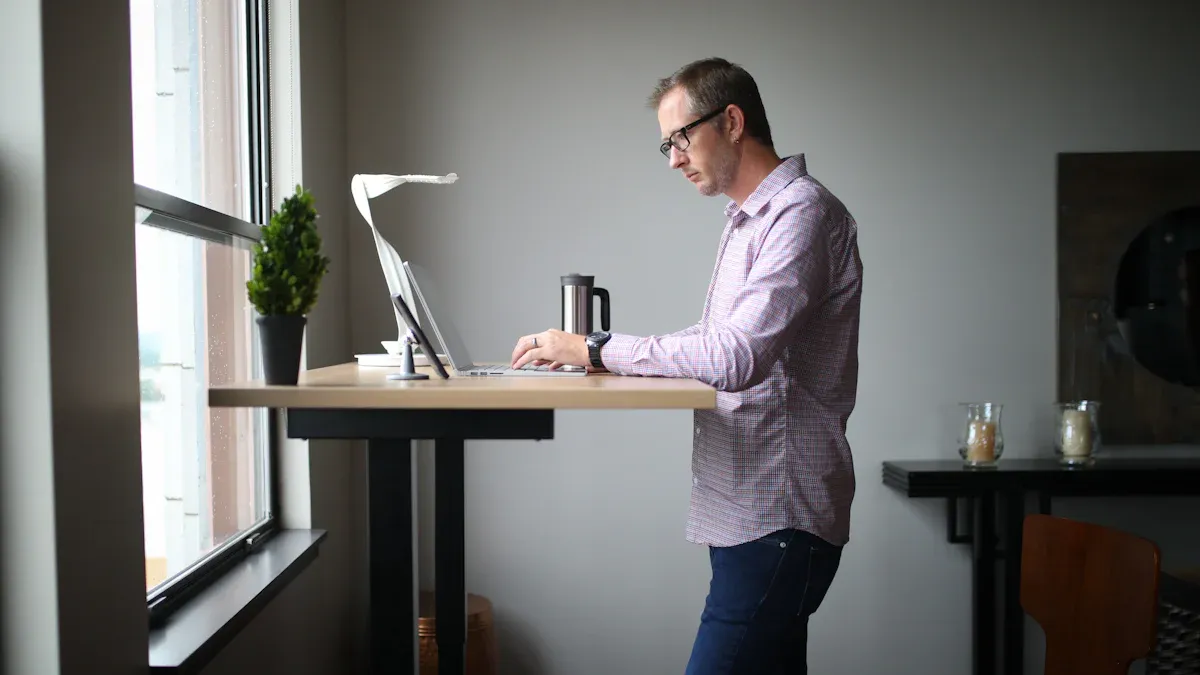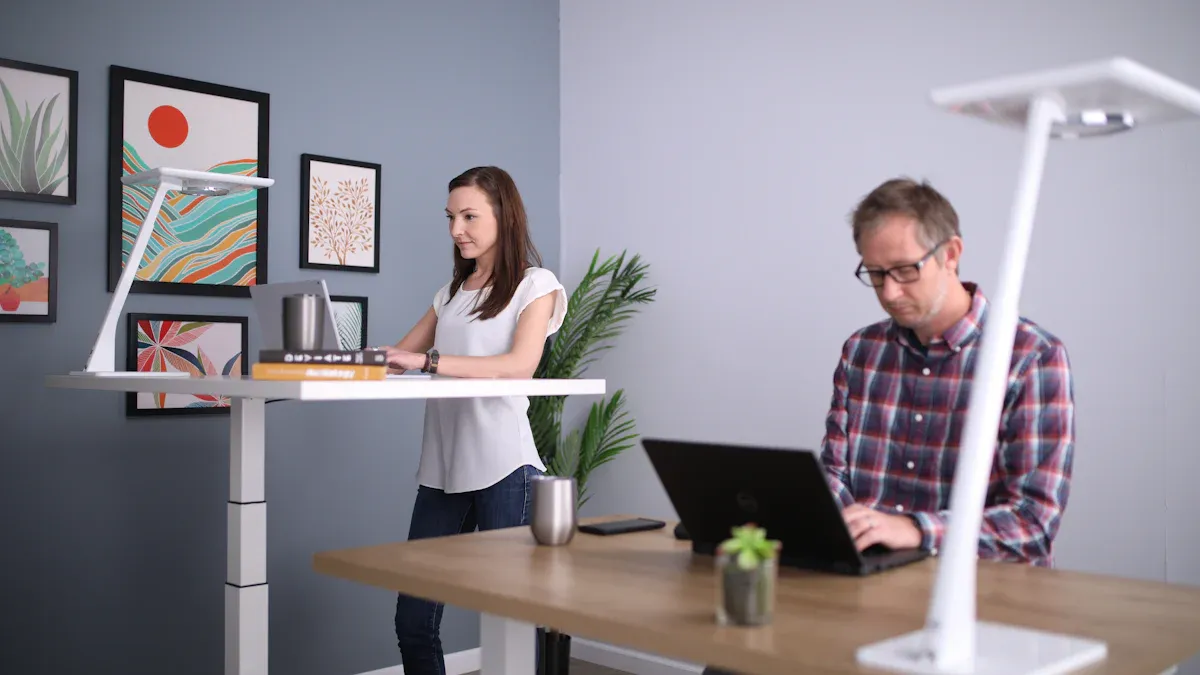
You might wonder if sit-stand desks are a smart buy in 2025. The answer is yes, for many people and companies, these desks make a real difference. You can see better posture, more energy, and happier workdays. Sure, sit-stand desks price tags vary, but even a Pneumatic Folding Adjustable Desk brings value. If you want to boost your comfort and health, these desks are worth a close look.
Key Takeaways
- Sit-stand desks help improve posture, reduce back and neck pain, and boost energy during the workday.
- Switch between sitting and standing every 30 to 60 minutes to keep your body comfortable and alert.
- Adjust your desk height and screen position properly to avoid new aches and get the most benefit.
- Consider your workspace size, budget, and daily routine before buying a sit-stand desk.
- If a sit-stand desk is not an option, small changes like desk converters or stretch breaks can still improve comfort.
Sit-Stand Desks: Proven Benefits in 2025

Health Improvements and Posture
You probably spend a lot of time at your desk. Sitting all day can make your back hurt and your shoulders stiff. Sit-stand desks help you move more. When you stand up, you stretch your legs and straighten your back. Many people say their posture gets better after using these desks. You might notice less pain in your neck and lower back. Doctors often recommend standing for short periods to keep your body healthy.
Tip: Try switching between sitting and standing every 30 to 60 minutes. Your body will thank you!
Productivity and Energy Levels
Do you ever feel sleepy after lunch? Sit-stand desks can help you stay alert. When you stand, your blood flows better. You feel more awake and ready to work. Some workers say they finish tasks faster when they use a sit-stand desk. You may find it easier to focus on your job. A little movement can boost your energy and help you avoid that afternoon slump.
- Stand up for a quick call.
- Sit down when you need to write or type.
- Mix it up to keep your mind sharp.
User Satisfaction and Wellbeing
People who use sit-stand desks often feel happier at work. You get to choose how you work best. This freedom can make your day more enjoyable. Many users report less stress and more comfort. Some even say they look forward to work because they feel better. When you feel good, your mood improves. You may even notice you smile more during the day.
Sit-Stand Desks: Potential Drawbacks

Cost and Financial Considerations
You might notice that sit-stand desks often cost more than regular desks. Some models can get pricey, especially if you want extra features like electric height adjustment or built-in charging ports. If you work for a company, your boss may need to buy several desks at once. That can add up fast. Even if you buy just one for your home office, you still need to think about your budget.
Tip: Before you buy, compare prices and check reviews. Sometimes, a simple manual desk works just as well as a fancy one.
Ergonomics and Proper Usage
You can’t just stand all day and expect to feel great. Using a sit-stand desk the wrong way may cause new aches or pains. If you set the height too high or too low, your wrists or shoulders might hurt. You need to learn how to switch between sitting and standing the right way. Some people forget to move and end up standing too long. That can make your legs tired.
- Adjust your desk so your elbows form a 90-degree angle.
- Keep your screen at eye level.
- Change positions often.
Practicality in Different Work Environments
Not every workspace fits a sit-stand desk. If you work in a small room, you may not have enough space. Some offices have fixed furniture or shared desks, which makes switching harder. You might also find it tricky to use these desks in places with lots of wires or equipment. Sometimes, your job just doesn’t match with standing while you work.
Note: Think about your daily tasks and your workspace before you decide to buy.
Sit-Stand Desks: Pros and Cons Compared
Weighing Health and Productivity Gains
You want to know if the benefits really stack up. Let’s break it down. When you use a sit-stand desk, you can move more during your workday. This movement helps your body feel better. You may notice less back pain and fewer stiff muscles. Your energy can go up, especially in the afternoon. Some people say they get more done because they feel more awake.
But you might not see huge changes right away. The health gains often come from using the desk the right way. If you stand too long or forget to adjust your desk, you could feel tired or sore. You need to find a good balance between sitting and standing.
Here’s a quick look at the main points:
| Pros | Cons |
|---|---|
| Better posture | Can cause leg fatigue |
| More energy | Needs proper setup |
| Less back and neck pain | Takes time to adjust |
| May boost productivity | Not always a quick fix |
Tip: Start slow. Try standing for short periods and see how your body feels.
Who Benefits Most from Sit-Stand Desks?
You might wonder if these desks work for everyone. Some people see bigger benefits than others. If you spend hours at a computer, you could notice a big difference. Office workers, students, and people who work from home often like these desks. If you have back pain or want to move more, you may feel better with a sit-stand desk.
People who like to change positions during the day also enjoy these desks. If you get restless or bored sitting, standing can help you stay focused. Some teams in creative jobs use these desks to keep ideas flowing. You might even see teachers or gamers using them now.
- Office workers
- Remote employees
- Students
- Creative professionals
Note: If you already move a lot at work, you may not need a sit-stand desk.
When Sit-Stand Desks May Not Be Worth It
Not every job or person needs a sit-stand desk. If you work in a small space, you might not have room for one. Some jobs need special equipment that does not fit well on these desks. If you only use your desk for short periods, you may not see much benefit.
You should also think about your budget. Some sit-stand desks cost a lot. If you do not plan to use it every day, you might want to try other options first. Sometimes, a simple standing mat or a few stretch breaks can help just as much.
Callout: Always check your workspace and your needs before you buy. The best choice is the one that fits your life.
Sit-Stand Desks: Making the Best Choice in 2025
Key Factors Before Investing
You want to make a smart choice before you buy a new desk. Start by thinking about your daily routine. How many hours do you spend at your desk? Do you often feel stiff or tired? If you work long hours, a sit-stand desk might help you feel better. Check your workspace. Make sure you have enough room for a desk that moves up and down. Look at your budget, too. Some desks cost more than others. Ask yourself if you will use the desk every day. If you share your space, talk to others who use it.
Tip: Write down your needs and measure your space before you shop.
Maximizing Value and Comfort
You can get the most out of your sit-stand desk by setting it up the right way. Adjust the height so your elbows stay at a 90-degree angle when you type. Keep your screen at eye level. Use a soft mat to stand on if your feet get tired. Try to switch between sitting and standing every hour. Listen to your body. If you feel sore, take a break or change your position. You can also add a footrest or a supportive chair for extra comfort.
Here’s a quick checklist:
- Adjust desk height for your body
- Use a standing mat
- Change positions often
- Keep your monitor at eye level
Alternatives to Sit-Stand Desks
You have options if a sit-stand desk does not fit your needs. Try a desk converter. It sits on top of your current desk and lets you raise your keyboard and monitor. You can also use a standing mat or take short breaks to stretch. Some people use balance boards to move while they stand. Even a simple routine of walking around every hour can help you feel better.
Note: You do not need fancy gear to stay healthy. Small changes can make a big difference.
You want to feel good at work and stay healthy. Sit-stand desks can help you move more and feel less tired. You might notice better posture and more energy. Some desks cost more, and you need to use them the right way. Think about your space, your budget, and how much you sit each day. Try standing for short times first. Listen to your body and make changes that fit your life.
FAQ
How long should you stand at a sit-stand desk each day?
Most experts suggest you stand for 15 to 30 minutes every hour. You can start with short periods and add more time as you get used to it. Listen to your body and switch when you feel tired.
Do sit-stand desks help with back pain?
Many people say their back feels better after using a sit-stand desk. You move more and avoid sitting too long. If you already have back pain, talk to your doctor before making changes.
Can kids or teens use sit-stand desks for schoolwork?
Yes! Sit-stand desks work well for students. You can move more and stay focused on homework. Just make sure the desk fits your height. Ask an adult to help set it up.
Are there any risks to using a sit-stand desk?
If you stand too long or use the wrong height, you might feel sore. Change positions often and check your setup. Use a mat for comfort.
Tip: Take breaks and stretch to avoid aches.
What if you can’t afford a sit-stand desk?
You have options! Try a desk converter or stack books to raise your monitor. Stand up during calls or stretch every hour.
- Small changes can help you feel better without spending much.
Post time: Jun-17-2025
